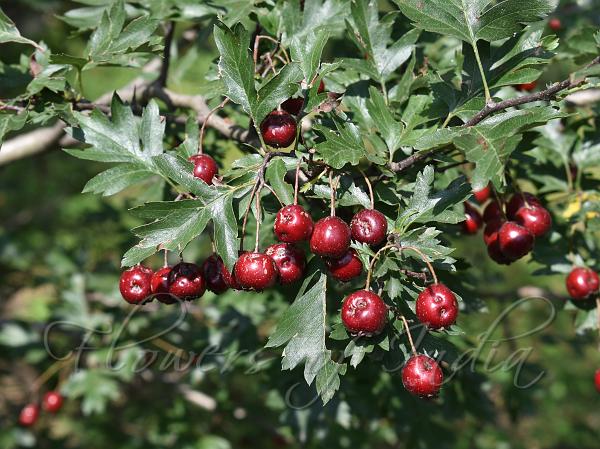|
| Asian Hawthorn |
|

|

| File size | 885308 |
| Original date | 8/4/20 3:22 PM |
| Resolution | 4496 x 3000 |
| Flash | Flash did not fire, auto |
| Focal length | 55.0mm |
| Exposure time | 1/250s |
| Aperture | 8.0 |
| Focus Distance | |
| Metering Mode | Multi-segment |
| Camera make | NIKON CORPORATION |
| Camera model | NIKON D5600 |
| Sensor type | OneChipColorArea |
|
|
|
|
Photo: |
Botanical name: Crataegus songarica Family: Rosaceae (Rose family)
Synonyms: Crataegus darvasica, Crataegus fischeri, Crataegus gharanica
Synonyms: Crataegus darvasica, Crataegus fischeri, Crataegus gharanica
Asian Hawthorn is a shrub or small tree, 4-5 m tall,
armed or unarmed; thorny 0.8-1.5 cm, stout. The white flowers have
18-20 stamens with purple anthers, and occur in groups of 10-20.
Flower-stalks are 0.5-1.5 cm, slightly velvet-hairy when young. Sepal
cup is bell-shaped, initially velvet-hairy, soon hairless. Sepals are
triangular-ovate or broadly lanceshaped, about 3 mm, below initially
velvet-hairy, becoming hairless. Petals are absent. Branchlets are
purplish brown when young, grayish brown when old, initially sparsely
velvet-hairy, soon hairless, round; buds reddish brown, ovoid,
hairless. Stipules are sickle shaped or lanceshaped, about 8 mm,
herbaceous. Leaf-stalks are 2-2.5 cm, hairless or nearly hairless; leaf
blade rhomboidal-ovate to broadly ovate, 3.5-6.5 x 2.5-5.5 cm, both
surfaces velvet-hairy when young, becoming hairless, base wedge-shaped,
rarely broadly wedge-shaped, margin remotely sawtoothed and with 2 or 3
pairs of deep lobes, or shallowly lobed at the tip, lobes oblong, tip
pointed. Fruit is reddish black with yellow pulp, sparsely dotted,
spherical, rarely ellipsoid, 1.2-1.6 cm in diameter, hairless; sepals
persistent, reflexed. Asian Hawthorn is found in Iran to NW China and W
Himalaya, at altitudes of 500-2000 m. Flowering: May-June.
Medicinal uses: The extract or juice of of the
plant, locally known as Ghingaaru, is used as a tonic in heart diseases
in Chambaa, Kaanaataal, Ghanshmal, Bhilanganaa valley, Jamunaa valley,
Taunt areas of NW Himalayas. In Kashmir region, it is also used locally
in heart diseases. According to the Wealth of India, the fruits are
used as & cardiac tonic. They are used as a marmalade. A beverage,
similar to tea, is also prepared from the rind and pip.
The extract or juice of of the
plant, locally known as Ghingaaru, is used as a tonic in heart diseases
in Chambaa, Kaanaataal, Ghanshmal, Bhilanganaa valley, Jamunaa valley,
Taunt areas of NW Himalayas. In Kashmir region, it is also used locally
in heart diseases. According to the Wealth of India, the fruits are
used as & cardiac tonic. They are used as a marmalade. A beverage,
similar to tea, is also prepared from the rind and pip.
Medicinal uses:
 The extract or juice of of the
plant, locally known as Ghingaaru, is used as a tonic in heart diseases
in Chambaa, Kaanaataal, Ghanshmal, Bhilanganaa valley, Jamunaa valley,
Taunt areas of NW Himalayas. In Kashmir region, it is also used locally
in heart diseases. According to the Wealth of India, the fruits are
used as & cardiac tonic. They are used as a marmalade. A beverage,
similar to tea, is also prepared from the rind and pip.
The extract or juice of of the
plant, locally known as Ghingaaru, is used as a tonic in heart diseases
in Chambaa, Kaanaataal, Ghanshmal, Bhilanganaa valley, Jamunaa valley,
Taunt areas of NW Himalayas. In Kashmir region, it is also used locally
in heart diseases. According to the Wealth of India, the fruits are
used as & cardiac tonic. They are used as a marmalade. A beverage,
similar to tea, is also prepared from the rind and pip. | Identification credit: Anil Thakur | Photographed in cultivation in Shimla. |
• Is this flower misidentified? If yes,